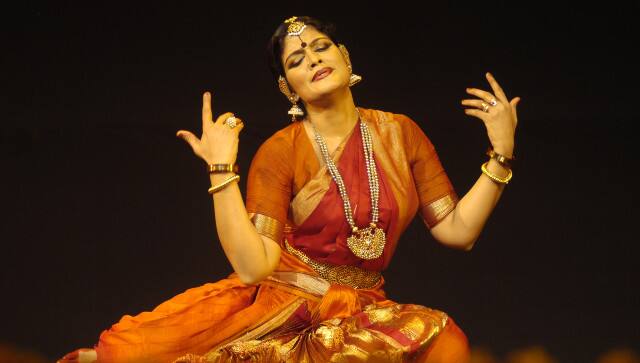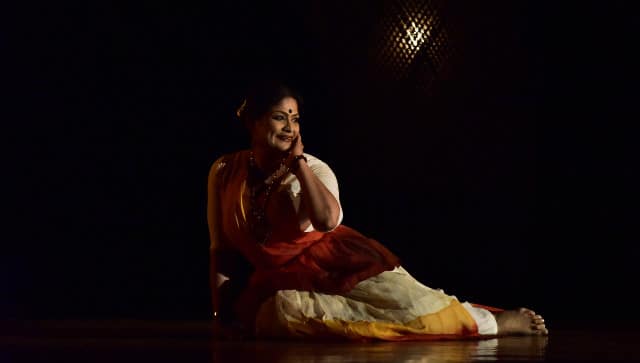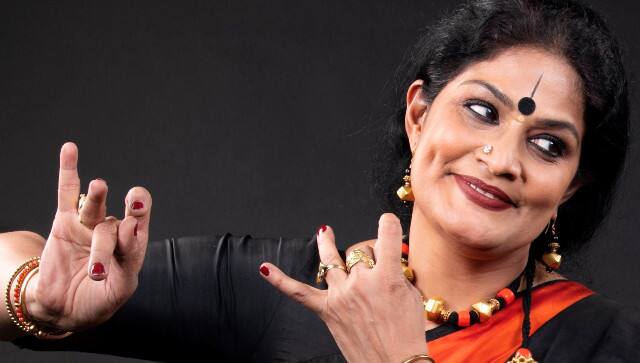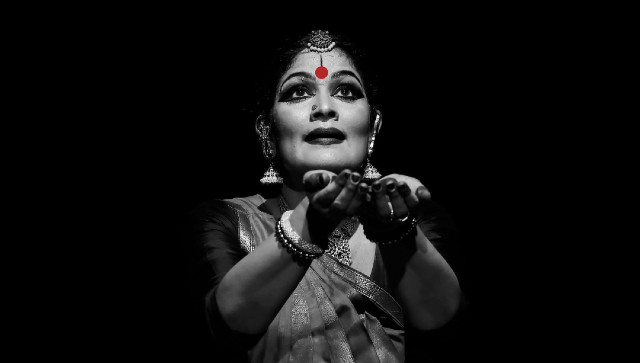Starting from the age of five, Bharatnatyam dancer Geeta Chandran has spent the last 55 years teaching and performing the classical dance, which has proved to be her “constant paramour and consort”. Even after spending more than half a century with Bharatnatyam, she remains in an unceasing learning phase with the humble thought in her mind that one life is not enough to fully understand it. Talking to Firstpost, she admitted that learning in her early childhood was an innocent act, rather than a serious awakening for the dance that happened later in her teenage. “It was in my teens that the dance awakened in me and I started wooing the dance. And that wooing has continued to this day. I love the dance – and I hope it loves me! Bharatanatyam is seeped in my spine and everything I think or do is seeped in that aesthetic,” Chandran said. But, could she, perhaps, take up another art form? A quick “no” comes in reply. “I never was inclined to venture into any other art form; I felt that this one life was itself not enough for me to fully understand Bharatanatyam. I couldn’t fool myself into thinking I could do more!,” the 60-year-old dancer said. [caption id=“attachment_10697371” align=“alignnone” width=“640”]
 The dance form is so deeply ingrained in Bharatnatyam dancer Geeta Chandran’s life that it has become her means of communication. [/caption] Through her performances, she has told stories of an ancient culture as well as articulated contemporary thoughts that sought to spotlight issues that concerned my conscience. Be it gender issues or the deteriorating environment, or Gandhian values of tolerance and inclusion, she communicated on stage through her “abhinaya” and “mudras”. After a hiatus of 30 months, forced upon the veteran dancer by the COVID pandemic, Chandran will be performing live for the first time on 21 May at the Stein Auditorium, India Habitat Centre in New Delhi. She will be premiering her new works in “In Search of Infinity” that reflect her internal journey through the COVID pandemic. For her, the prospect of returning to stage for a live solo performance with live musicians and a live audience is akin to “one at birthing”. “Only this time it’s a new performance that I have kept in my womb for 30 months. And its birthing is going to be a significant event in my life,” she said. Just like billions of people around the world, Chandran and the artist community at large was torn away from their routine life that involved performances, lectures and travelling. It was in the first wave of the COVID-19 in June, 2020 that Chandran and all 13 members of her family were in the throes of the deadly disease at a time when the world was still trying to figure out the virus. [caption id=“attachment_10697361” align=“alignnone” width=“640”]
The dance form is so deeply ingrained in Bharatnatyam dancer Geeta Chandran’s life that it has become her means of communication. [/caption] Through her performances, she has told stories of an ancient culture as well as articulated contemporary thoughts that sought to spotlight issues that concerned my conscience. Be it gender issues or the deteriorating environment, or Gandhian values of tolerance and inclusion, she communicated on stage through her “abhinaya” and “mudras”. After a hiatus of 30 months, forced upon the veteran dancer by the COVID pandemic, Chandran will be performing live for the first time on 21 May at the Stein Auditorium, India Habitat Centre in New Delhi. She will be premiering her new works in “In Search of Infinity” that reflect her internal journey through the COVID pandemic. For her, the prospect of returning to stage for a live solo performance with live musicians and a live audience is akin to “one at birthing”. “Only this time it’s a new performance that I have kept in my womb for 30 months. And its birthing is going to be a significant event in my life,” she said. Just like billions of people around the world, Chandran and the artist community at large was torn away from their routine life that involved performances, lectures and travelling. It was in the first wave of the COVID-19 in June, 2020 that Chandran and all 13 members of her family were in the throes of the deadly disease at a time when the world was still trying to figure out the virus. [caption id=“attachment_10697361” align=“alignnone” width=“640”]
 She will be premiering her new works in “In Search of Infinity” that reflect her internal journey through the COVID pandemic.[/caption] Uncertainties were endless and fears were unsurmountable when it came to tackling the virus and measures to heal from the unfamiliar illness. “We faced stigma and discrimination as we were treading an unfamiliar illness. We had large red posters stuck on our gate with our photos on them announcing our quarantine periods. It was a very very strange time,” Chandran recalled. Before the forever-ennui could set in her limbs, Chandran decided to take the “pandemic by its horns and not succumb to its numbness”. She learned to handle online classes and provided psychosocial support to her students and their families. For the next 30 months, she continued the routine and also used the “premium time on her hands” to take on creative projects that were kept in abeyance for want of time. “…There I was with a slew of incomplete ideas that had to be brought to fruition; and I finally had the uninterrupted time to tackle those tasks. And so it was that yoga, dance, and my creative urge peaked during those long, long months that would have seemed interminable, but for my dance!” Chandran said. [caption id=“attachment_10697351” align=“alignnone” width=“640”]
She will be premiering her new works in “In Search of Infinity” that reflect her internal journey through the COVID pandemic.[/caption] Uncertainties were endless and fears were unsurmountable when it came to tackling the virus and measures to heal from the unfamiliar illness. “We faced stigma and discrimination as we were treading an unfamiliar illness. We had large red posters stuck on our gate with our photos on them announcing our quarantine periods. It was a very very strange time,” Chandran recalled. Before the forever-ennui could set in her limbs, Chandran decided to take the “pandemic by its horns and not succumb to its numbness”. She learned to handle online classes and provided psychosocial support to her students and their families. For the next 30 months, she continued the routine and also used the “premium time on her hands” to take on creative projects that were kept in abeyance for want of time. “…There I was with a slew of incomplete ideas that had to be brought to fruition; and I finally had the uninterrupted time to tackle those tasks. And so it was that yoga, dance, and my creative urge peaked during those long, long months that would have seemed interminable, but for my dance!” Chandran said. [caption id=“attachment_10697351” align=“alignnone” width=“640”]
 Chandran was awarded Padma Shri by the government of India in 2007 for her contribution to the field of art.[/caption] The pandemic, however, was a lot more difficult for several other artists as they were “robbed of their regular sources of income” and yet had to tend to all the financial obligations. She highlighted their plight that efforts should have been made to help the struggling artists. “Performing artists in India are daily-wage earners. Yet, no economic studies or research has revealed their sorry plight….no special efforts were made to ameliorate the plight of performing artists. We were jealous of so many nations that offered succor to their artists; but here, we had none!,” she rued. Her Saturday’s performances have been choreographed and compiled based on what she felt, experienced in the last 30 months. She includes compositions like legendary Hindi poet Jai Shankar Prasad’s Beeti Vibhavari Jaag Ri as a potent metaphor for the dark days of the pandemic that need to be put aside, as a new day rises but with abundant caution. In another performance, she depicts the episode of Lord Krishna lifting the Govardhan mountain to explore various nava-rasas in her dance including the emotions of sorrow, wonder, disgust, and love that she experienced closely during the pandemic. Verses in Sanskrit from the Sri Krishna Karnamritam shlokam of Bilvamangala Swami become the libretto for this exploration in music and abhinaya. Read all the Latest News
, Trending News
,
Cricket News
, Bollywood News
, India News
and Entertainment News
here. Follow us on
Facebook
,
Twitter
and
Instagram
.
Chandran was awarded Padma Shri by the government of India in 2007 for her contribution to the field of art.[/caption] The pandemic, however, was a lot more difficult for several other artists as they were “robbed of their regular sources of income” and yet had to tend to all the financial obligations. She highlighted their plight that efforts should have been made to help the struggling artists. “Performing artists in India are daily-wage earners. Yet, no economic studies or research has revealed their sorry plight….no special efforts were made to ameliorate the plight of performing artists. We were jealous of so many nations that offered succor to their artists; but here, we had none!,” she rued. Her Saturday’s performances have been choreographed and compiled based on what she felt, experienced in the last 30 months. She includes compositions like legendary Hindi poet Jai Shankar Prasad’s Beeti Vibhavari Jaag Ri as a potent metaphor for the dark days of the pandemic that need to be put aside, as a new day rises but with abundant caution. In another performance, she depicts the episode of Lord Krishna lifting the Govardhan mountain to explore various nava-rasas in her dance including the emotions of sorrow, wonder, disgust, and love that she experienced closely during the pandemic. Verses in Sanskrit from the Sri Krishna Karnamritam shlokam of Bilvamangala Swami become the libretto for this exploration in music and abhinaya. Read all the Latest News
, Trending News
,
Cricket News
, Bollywood News
, India News
and Entertainment News
here. Follow us on
Facebook
,
Twitter
and
Instagram
.
One life is not enough to fully understand Bharatanatyam: Geeta Chandran
Manish Sain
• May 20, 2022, 12:31:55 IST
After a hiatus of 30 months, forced upon the veteran dancer by the COVID pandemic, Chandran will be performing live for the first time on 21 May at the Stein Auditorium, India Habitat Centre in New Delhi
Advertisement
)
End of Article